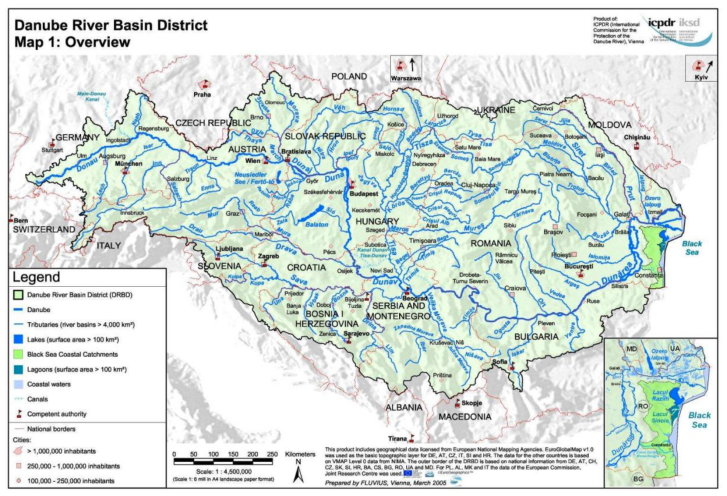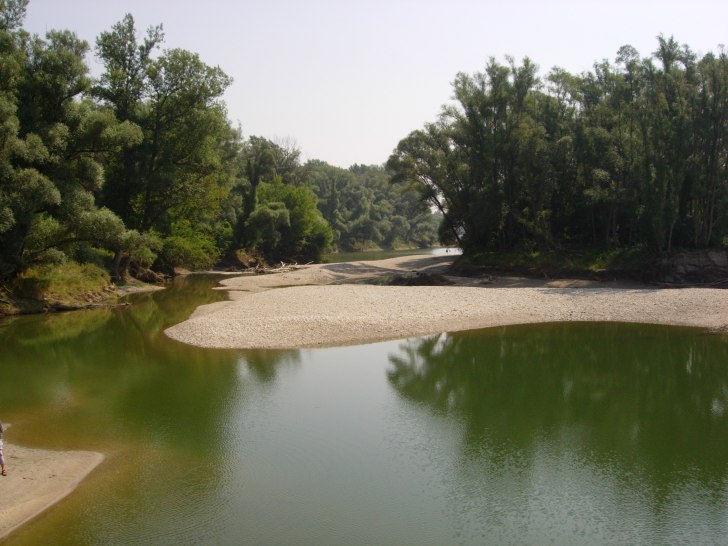The AQUACROSS Assessment Framework: supporting effective floodplain restoration in the Danube Basin

A fallen tree on the bank of the Danube River. Image: Andrea Funk | AQUACROSS
The Danube is one of the great rivers of Europe, with a catchment of 800,000km2 which is home to more than 80 million people from 19 countries. The diversity of human life in the Danube basin is mirrored by its biogeographic diversity, moving from high Alpine mountain streams to looping lowland meanders and floodplains as the river flows 2,800km eastwards to its estuary in the Black Sea. As a result, the Danube basin provides habitat for a rich range of biodiversity, notably for wetland birds, freshwater molluscs and fish, including five species of endangered sturgeon and the Danube salmon, or huchen.
Sadly, the numerous human activities in the Danube basin have placed significant pressures on the ecological health and status of the river. Throughout the basin, the construction of hydropower plants, expansion of agriculture, and large-scale river regulation measures for navigation and flood protection are causing extensive hydromorphological pressures on the river ecosystem. As a result, in many parts of the Danube basin, natural floodplain areas have been disconnected from the river channel, or lost altogether, causing significant ongoing losses of habitat and biodiversity.
Multiple pressures, multiple policies
In response to these pressures, schemes to restore river-floodplain systems have been developed throughout the Danube basin. These restoration schemes relate to the implementation of a number of wider policy instruments, including the EU Biodiversity Strategy to 2020, the EU Strategy of the Danube Region, the Danube River Basin Management Plan for the Water Framework Directive, the EU Floods Directive, and the Birds Directive and Habitats Directive.
The diversity of these policies reflects the range of potential benefits to biodiversity, ecological status, natural flood protection and climate change mitigation that river-floodplain restoration can foster. However, the complexity of environmental problems and cross-border legislation in the Danube basin, coupled with a lack of adequate ecological data on the river ecosystem has significantly hampered floodplain restoration efforts. As a result, only a few countries in the Danube region have already implemented (or even planned) restoration activities, which are due by 2021.

The Danube is the ‘most multinational river in the world’ according to the WWF. Image: ICPDR
The AQUACROSS Assessment Framework
To try to support floodplain restoration efforts across the Danube basin, the EU AQUACROSS project undertook research on the river using their Assessment Framework. The framework addresses three main factors to identify suitable sites for restoration and conservation. First, the remaining ‘multi-functionality’ of the system, in other words, the health and diversity of the ecosystem, even when highly pressured by human activities. Second, the ‘reversibility’ of the degraded ecosystem, or the potential to restore a multi-functional ecosystem. Third, the availability of remaining semi-natural land versus agricultural land in riparian areas around the river channel.
Essentially, the AQUACROSS Assessment Framework allows for the identification of sites for floodplain restoration where habitat, biodiversity and ecosystem service provision can be improved concurrently. The Framework is based on the joint application of Bayesian Biodiversity models and Ecosystem Service Models (ARIES). This integrated approach, which brings together multiple objectives for promoting biodiversity, ecosystem services and socio-economic benefits together, is designed to facilitate the implementation of ecosystem-based management in the Danube basin.
Assessing ‘baseline’ and ecosystem-based management approaches
When the AQUACROSS Assessment Framework was applied in the Danube basin, indicators for biodiversity, ecosystem services (such as flood retention, crop pollination and recreation potential), pressures (such as hydromorphological alteration) and drivers (such as land-use and hydropower) were modelled for two future scenarios: baseline (i.e. ‘business as usual’) and ecosystem-based management. At all stages, this process was supported by engagement with stakeholders across the basin.
The AQUACROSS results suggest that a ecosystem-based management approach can be more cost-effective in restoring floodplain biodiversity and ecosystem services than the baseline approach. They indicate that the multiple priorities considered by the ecosystem-based management create the opportunity to pursue different policy objectives simultaneously, and in so doing offer the potential to foster cross-border coordination of policy implementation and data sharing for floodplain restoration.
The AQUACROSS team highlight that the ecosystem-based management approach can thus help support the selection of restoration sites, whether under Habitats Directive protected areas, Water Framework River Basin Management Plans, or Floods Directive Flood Management Plans. In short, the AQUACROSS Assessment Framework provides an invaluable tool for helping restoring the health and status of the Danube basin under multiple human pressures.

A connected floodplain sidearm channel of the Danube. Image: Andrea Funk | AQUACROSS
Reflections on the AQUACROSS Danube project
Andrea Funk, a lead AQUACROSS scientist on the Danube case study says, “Linking available multi-disciplinary data within a new model framework allows us to systematically prioritise floodplain segments along the Danube for conservation and restoration, partially confirming already designated restoration sites, as well as identifying others in areas where no sites are yet designated.”
Thomas Hein, a lead AQUACROSS scientist on the Danube case study says, “The cooperation of different leading scientific institutions and key stakeholders in the Danube River Basin allowed to define highly relevant research objectives and provided new results on a quantitative modelling approach to identify the biodiversity and ecosystem service potential and thus, the potential for floodplain restoration.”
Ursula Scheiblechner, Project Manager with Danube river management stakeholder organisation viadonau says, “The AQUACROSS Danube case study gives us a very large-scale view from source to the mouth of the river Danube. viadonau has a decades-long tradition of realizing ecological projects at the Danube in Austria. During the planning and construction phase of a project we have to look very close at the particular project area and several effects of the measures. It was interesting for us, that the AQUACROSS Danube case study with its large- scale analysis comes to similar conclusions in determining relevant restoration sites at the Danube as we do.”
+
Find out more:















Comments are closed.